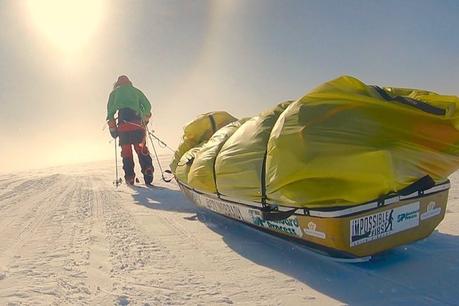
While we were away for the holiday break (and busy launching a new website!) a lot happened in the Antarctic. In case you missed the previous updates, both Colin O'Brady and Lou Rudd finished up their independent traverses of the frozen continent, writing their names in the history books as a result. O'Brady finished a few days ahead of his British rival, putting in an epic 32 hour final push to the finish line. In the process he became the first person to complete a crossing of the Antarctic in a solo and unassisted fashion. But, as it turns out, there some questions have arisen regarding what "unassisted" actually means.
Explorers Web first published a story that called into question O'Brady and Rudd's unassisted status when it was revealed that both men skied along a road for nearly the entire return trip from the South Pole to the Antarctic coast at the Ross Ice Shelf. That is a distance of about 600 km (372 miles), which O'Brady covered in just 15 days. That's a fairly quick pace for an Antarctic skier, but not necessarily unheard of, particularly with Colin's massive final push to the end. Rudd wasn't far behind, wrapping up just two days behind the American.
Reportedly, this road -- which is called the McMurdo-South Pole Highway, or the South Pole Overland Traverse Road (SPOT) -- is used to bring supplies to the Amundsen-Scott Station located at the Pole. Although it is made of packed snow and ice, it allow vehicles to make the journey safely and much more quickly. The same can be said of the two skiers as well.
Polar guide Eric Phillips described the SPOT to ExWeb by saying, "It is a highway." Adding that the road "more than doubles someone's speed and negates the need for navigation. An expedition cannot be classed as unassisted if someone is skiing on a road."
The reason Phillips says that the road eliminates the need for navigation is that it features flags that have been put into place ever 100 meters. These flags are meant to help break up the endless white of the Antarctic for vehicles traveling along the "highway," helping them to know where the road is located. For skiers, that means they don't have to look at their GPS or compass at all, and can simply glide along what amounts to a groomed trail, saving themselves a lot of time in the process.
The so called "rules" of exploration and adventure indicate that using a road of this kind would be seen as having some assistance, just the same as using a kite or dog sled or instance. That would also indicate that neither O'Brady or Rudd finished the traverse in solo and unassisted fashion, meaning that someone could still claim the first traverse of Antarctica in that fashion.
Personally, I have to say I was surprised when Colin reached the finish line so quickly after arriving at the South Pole. I expected that it would take both he and Rudd well into January before they would wrap up their expedition. I even indicated as much in the post announcing O'Brady's achievement. At the time I was unaware that either of the men were using a road to help speed things along. I guess explains how they wrapped things up so quickly, especially since both men estimated at 65-70 day expedition length and they finished 54 days in the case of O'Brady and 57 days for Rudd.
What say you adventure community? Unassisted or not? It's going to be interesting to see how this plays out.

